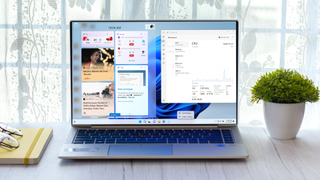Microsoft is adding support for AMD’s neural processors in Windows – here’s why it matters
Microsoft is preparing for the impending rise of hardware-accelerated local AI tools, and while the first steps may seem boring, they are important.
Yes, I’m going to talk about Task Manager – wait, don’t leave! I know, it’s not exactly the most glamorous topic out there, but this is an important development. AMD has announced that it is working with Microsoft to add support for the former’s latest version neural processing units (NPUs) under Windows; specifically, enabling the Microsoft Compute Driver Model (MCDM) for the AMD chips, which allows Task Manager to monitor NPU resource usage in the same way it does for the CPU, GPU, and your other components.
It’s likely a relief for AMD, as its biggest rival, Intel, already has MCDM support for its own on-chip NPUs, despite Team Red being first in the NPU market. AMD commended Microsoft for recognizing the importance of neural processing hardware, noting that the use of AI – which can be accelerated by a local NPU – is likely to increase in the coming years and praising Microsoft’s efforts to “keep pace with the added complexity of PCs”.
What does this mean for you?
Every major chipmaker, including AMD, is currently on board the AI bandwagon, and that means dedicated hardware in your device for powering AI workloads. ‘Local’ AI has many advantages over currently available cloud-based AI tools such as ChatGPT, such as faster processing times, no need for a constant internet connection and superior user security; So it’s not hard to see why NPUs have become the new target of the gold rush.
In practice, this means that we will see more and more laptops and desktop PCs (and phones and tablets too!) with these special AI chips as standard. Microsoft’s upcoming integration for AMD’s NPUs is specific to the new laptop-only Ryzen 8040 chip series. While the initial functionality will be limited to monitoring the NPU within Task Manager, it paves the way for full hardware-accelerated AI within Windows.
But even the Task Manager integration is good and important – and if you don’t use Task Manager, you should too. It’s an invaluable tool for tracking how efficiently your computer is running, allowing you to see if your system is bottlenecking a single component or consuming power when running specific programs; it’s an extremely useful tool, especially for laptop users, who can use it to fine-tune their power settings for better battery life.
I was pleased to see that AMD agrees with my assessment, with a spokesperson saying that tracking resource allocation is “particularly important in notebooks where end users can choose to maximize battery life by monitoring where certain workloads are running or by adjusting general power settings”. Even if your laptop doesn’t have an NPU (most don’t right now), Task Manager can help you get the most out of battery life.
In any case, we’re probably only a year or two away from seeing them all best laptops with their own built-in NPUs, so Microsoft probably couldn’t afford to drag on any longer. It’s not completely clear AMD’s blog post whether this is a Windows 11 exclusive update or will also apply to older versions of the operating system, but I wouldn’t be surprised if it is the first – as we know, Microsoft Real want you to update!

